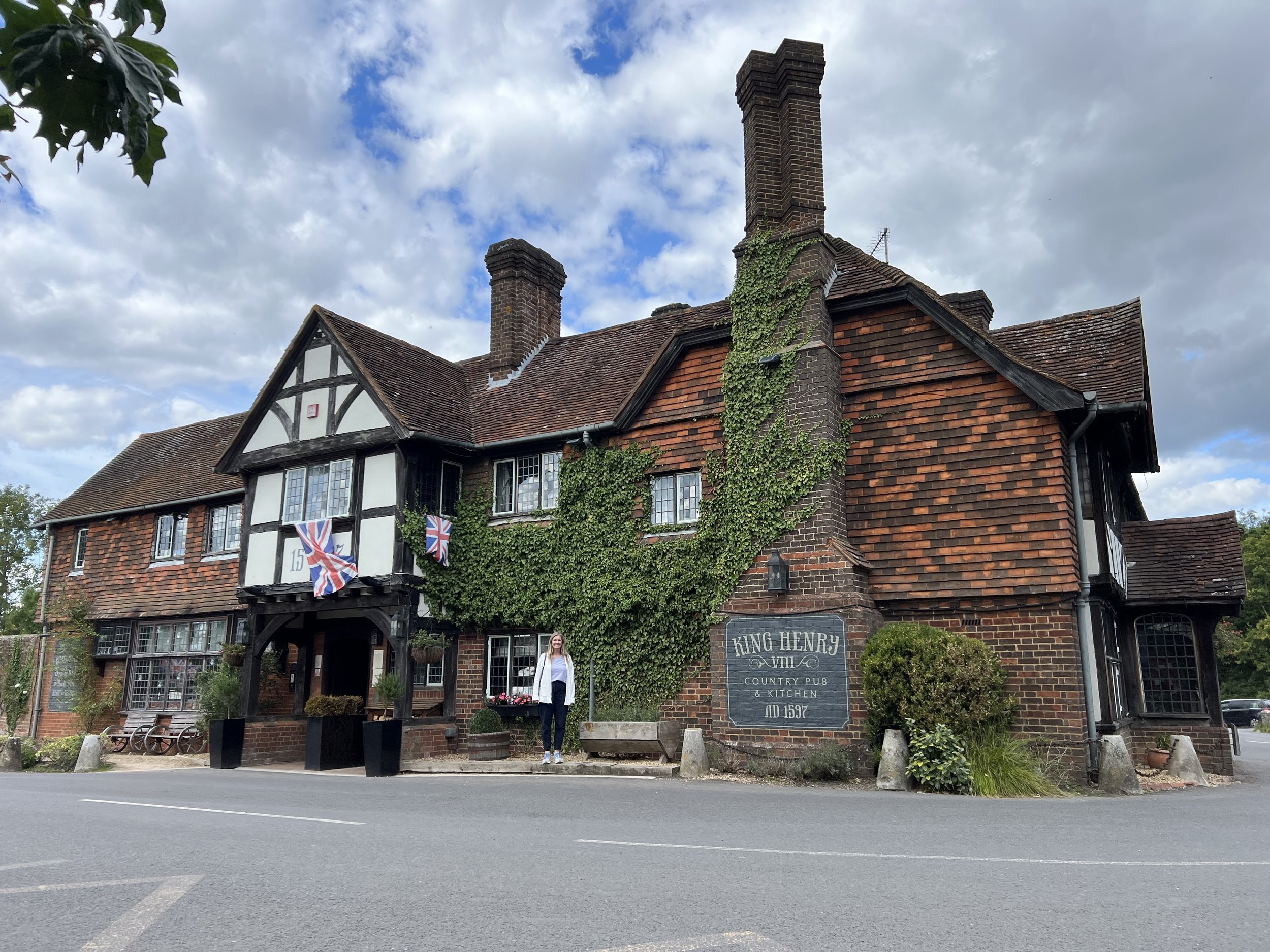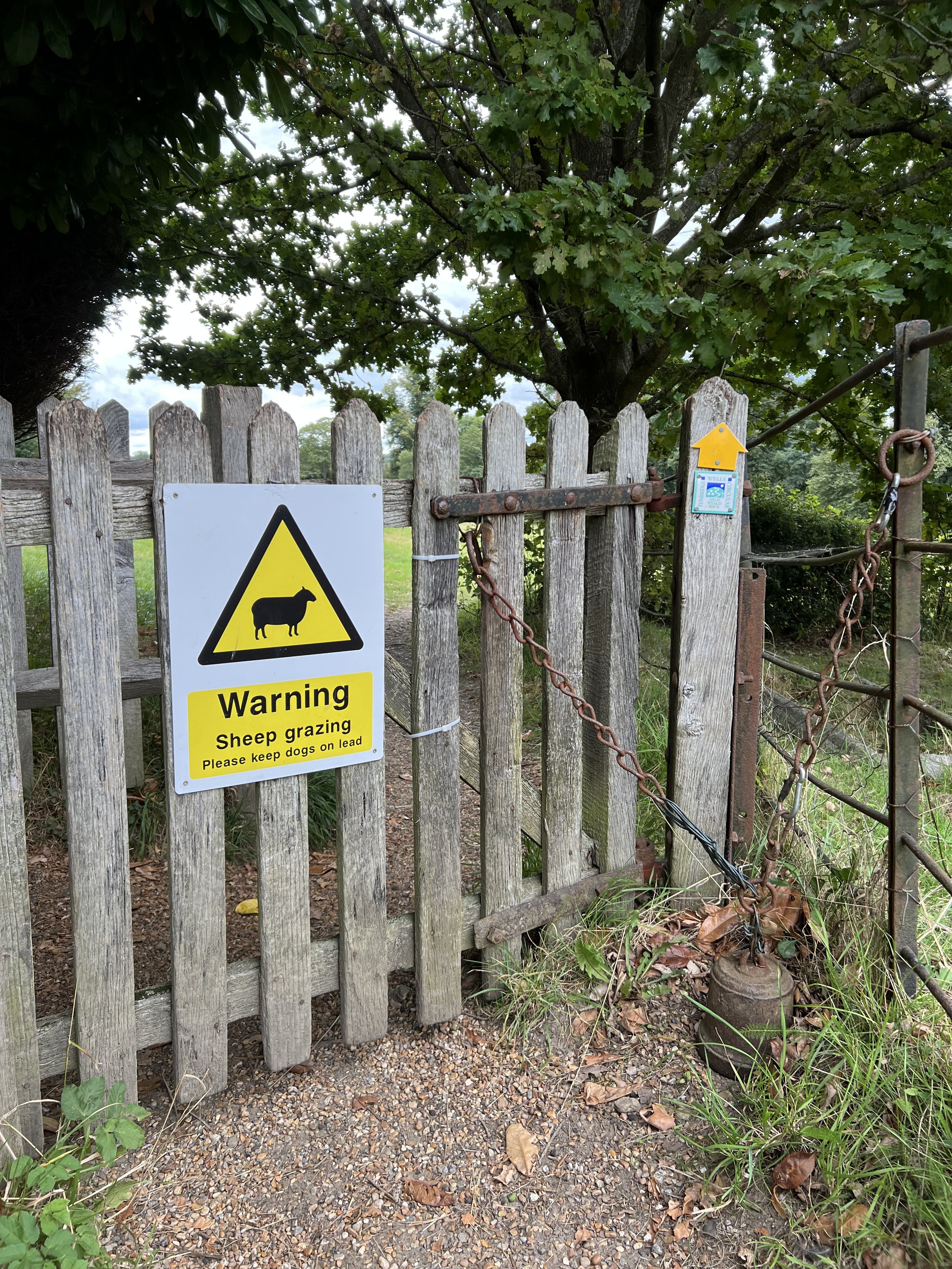A Queen & A Bear
“A day without a friend is like a pot without a single drop of honey left inside.”
Hever Castle
We left our apartment in Cambridge early and headed south, past London’s eastern outer ring, and arrived at Hever Castle—the childhood home of Anne Boleyn.
Of course Amanda loves Tudor England and nothing says “let’s try and tear this country apart” like Henry VIII.
In the time of Henry VIII, Hever Castle was the home to Thomas Boleyn and his wife Elizabeth Howard.
A gorgeous moated castle.
On the drawbridge with the first portcullis visible behind Amanda
One of the inner gate doors (with wicket), and a second portcullis.
A childhood portrait of Anne’s older sister Mary, with whom Henry had an affair before pursuing Anne.
A young Anne Boleyn
Replica of the clock given to Anne Boleyn by Henry VIll on their wedding day.
Like so many old buildings, Hever Castle was abandoned and in a state of decay until American William Waldorf Astor purchased the castle and its land in 1903. He wanted to preserve the castle itself and to perpetuate its historical associations.
He also wanted to live in 20th-century style and comfort, and to entertain lavishly. Astor transformed the space above into a sumptuous Drawing Room to entertain his famous guests.
The cottages you see behind the castle were also built by Astor to house his guests. He had them built to look like a small Tudor village.
The Great Hall where Henry VIII dined with the Boleyn family.
Henry VIII had his own locks installed on doors in every place he stayed. This is one of the surviving original locks that was never removed.
Catherine of Aragon (Henry VIII’s first wife) was a Spanish princes sent to England at 15 to marry Arthur Tudor, the eldest son of King Henry VII. But five months later, her new husband Arthur died suddenly. Her luck got a whole lot worse when she ended up married to Arthur’s younger brother Henry.
This rare 16th century oak panel is carved with the emblems of King Henry VIll and Queen Catherine of Aragon. The emblem combines a rose motif, relating to the Tudor family, and pomegranates, which are associated with the family and Spanish heritage of Catherine of Aragon.
Anne spent several years in the French court and became very graceful and charming as a result. Three years after she arrived back in England, Anne Boleyn caught the eye of King Henry Vlll who started to send her gifts and love letters, despite already being married to Catherine of Aragon for nearly 20 years.
There was one thing Catherine had never given Henry, which was the one thing he wanted most in the world—a son. Henry decided to marry Anne in the hope she would give him a son.
This plaque celebrates the marriages of Thomas Boleyn to Lady Elizabetn Howard (left) and King Henry VIll to Anne Boleyn (right).
Anne’s bedroom. The oak and walnut four-poster bed in Anne’s bedroom is c. 1485.
The bedroom done up as it likely would have been when Henry stayed at Hever.
Hever’s Long Gallery
Farewell Hever
Divorced, Beheaded, Died
Divorced. Beheaded, Survived
Henry VIII Pub
Just outside the entrance to Hever Castle sits the King Henry VIII pub, established in 1597. In case you’re wondering: Henry reigned from 1509-1547.
I tried a Cruzcampo, which was a Spanish lager on tap; very nice! The pub had actual candles burning throughout. Amazing ambiance.
Royal Tunbridge Wells
Our apartment that night was in the nearby town of Royal Tunbridge Wells.
After 9 1/2 months on the go, this was our final Vrbo/Airbnb! The fingerpost is reminiscent of those in Yorkshire.
Here is the town on the map and a short video tour of the apartment: https://www.youtube.com/watch?v=rVFPwbqWqHc
And here we are outside the Royal Tunbridge Wells Sainsbury’s (wishing we had our sunglasses), our last grocery store trip in the UK.
Groombridge Place
This sign depicts:
The Saxon noble Gromen who gave his name to the village.
The shields of Kent and Sussex, with the hops and vines of both counties.
The Gromen men joining hands over the River Grom uniting the old settlement in Kent with the new one in Sussex.
The anvil representing the iron works of the area.
The word Groombridge forming a bridge over the Grom and a steam train portraying the growth of the railway and the new village.
This picture depicts:
A very sad tourist who loved Groombridge Place in the Pride and Prejudice film as the Bennett family home.
A tourist who knew ahead of time that the house was closed for refurbishment.
A tourist who nonetheless really hoped she could at least see the house from the road, but was disappointed that that was not the case.
This sign depicts:
The wonderful public right-of-way laws in the UK (the little yellow arrow, not the sheep one).
The stubborn determination of the first tourist’s husband to find a way for his wife to see the house.
The house may be closed for restoration, but we were able to get really close to the house and stand where some of our favorite scenes were filmed!
Amazingly, the public footpath takes you nearly to the front door.
This current house was built in 1662. but it was constructed on the site of a small moated castle from 1239.
Apparently the house has been purchased by The Pig, a small upmarket boutique hotel chain and is set to open sometime in 2025. Sadly, it will never be seen again in its original glory as a family home. The front porch and room to the right were seen repeatedly in the film.
The small bridge crossing the moat, which Lizzie is seen crossing as the film opens.
This is the spot where Mr Bingley contemplates his botched first attempt at proposal to Jane. You can watch the scene below: https://www.youtube.com/watch?v=4BQZ_uaSf8U
Pooh Corner
Very near Groomsbridge, is the small village of Hartfield, where the Milne family lived. The fictional Hundred Acre Wood of the Pooh stories derives from Five Hundred Acre Wood in Ashdown Forest, where the Pooh stories were set. Milne lived on the northern edge of the forest at Cotchford Farm.
The building known today as Pooh Corner was, for many centuries, called Sackville Cottage (sign to the right of the door).
As well as homes, the cottages later became business premises, notably a bakery and general store. As a boy, Christopher Robin Milne would visit the store here buying bullseye sweets with his Nanny Olive and donkey Jessica.
The owner of Sackville sold the cottage in 1978 to Mike Ridley, who established Pooh Corner in honor of Christopher Milne as a tearoom and a gift shop.
Christopher Robin Milne with his grandfather, John Vine Milne, and Edward Bear (better know as Winnie-the-Pooh).
John Vine informed both A.A Milne's education and writing; it has been said that the elder Milne's character can be found in Owl, who is often considered the wisest of the creatures in the Hundred Acre Wood.
John Vine was exceptionally proud of his son's work, eagerly following the success of the Pooh books and their sales figures. A.A. Milne wrote Father seems so terribly happy and excited that he makes me feel ashamed of not having made him happy before.
Photos of Grandfather Milne together with the young Christopher are rare as John Vine Milne died in 1932 when Christopher was just 12 years old.
Do you know where the name “Pooh” comes from?
Christopher Robin Milne's stuffed bear, originally named Edward, was renamed Winnie after a Canadian black bear named Winnipeg, which was used as a military mascot in World War I, and left to London Zoo during the war. It was during a visit to the zoo that Christopher became enamored with the bear.
Christopher Milne also once named a swan “Pooh” while he and his family were on holiday in Sussex, near Arundel. They were staying at Decoy Cottage and nearby there were the Decoy Ponds, and it was on these ponds that a swan swam. A.A. Milne explained in the introduction to “Winnie-the-Pooh,” 1926:
"When we said good-bye, we took the name with us, as we didn't think the swan would want it any more. Well, when Edward Bear said that he would like an exciting name all to himself, Christopher Robin said at once, without stopping to think, that he was Winnie-the-Pooh. And he was.”
100 Aker Wood
Poo in the corner of Five Hundred Acre Wood in Ashdown Forest.
Christopher Robin’s childhood playground: Five Hundred Acre Wood in Ashdown Forest
“Plez cnoke if an rnsr is not reqid.”
Piglet is an anxious and shy little pig.
“The thing to do, when you’re feeling blue, is to make something useful out of it.” -Piglet
“I’m not afraid of heights. Just…not used to them.” -Piglet
Poohsticks Bridge
Poohsticks was invented by A.A. Milne for his son Christopher Robin Milne. The game first came to prominence upon Milne's description in his 1928 book, The House at Pooh Corner.
It is a simple game which may be played on any bridge over running water; each player drops a stick on the upstream side of a bridge and the one whose stick first appears on the downstream side is the winner.
This memorial to the creator of Winnie the Pooh in the heart of the Ashdown Forest’s Five Hundred Acre Wood is inscribed with a quote from The House at Pooh Corner,
“And by and by they came to an enchanted place on the very top of the Forest called Galleon’s Lap.”
Cotchford Hill—The Milne family home.
This was our second-to-the-last stop in our vast loop of the UK. Tomorrow (Wednesday, August 30) we visit Kew Gardens near London, then it’s Paris and home!
Wrapping Things Up
Our beloved frother! Alas, it’s built for 220v and has a UK plug, so little sense in taking it home with us. Fortunately, we were able to pack it up today and ship it to Jacqueline and Paul—which is quite fitting since they live near Glasgow and we bought it in Glasgow!
We also took a small hoard of other goods to a charity shop in Royal Tunbridge Wells. Time to lighten our load and get ready for our return trip home!
No more use for all these cards, time to throw them away. Boy oh boy did they save us money!



























































